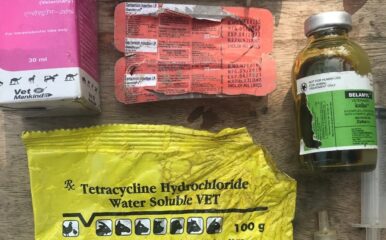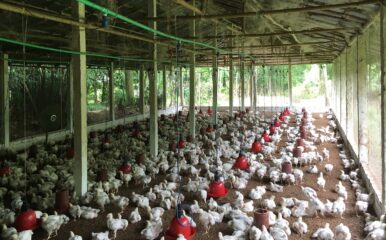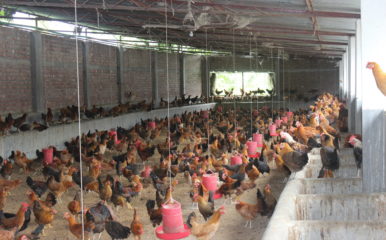
Sharing results for safer and more sustainable poultry production in Vietnam
Published on 18/05/2023
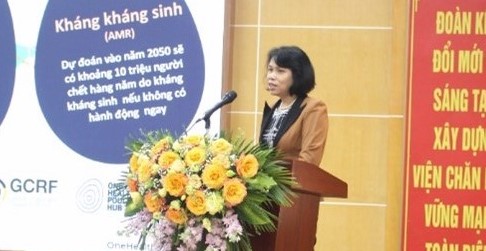
Khau Thi Dinh/NIAS
View this page in:
VietnameseA series of scientific seminars sharing early results from the One Health Poultry Hub in Vietnam were held in Hanoi with the output of these discussions, including empirical data, contributing to policy development in Vietnam. The topics covered –poultry disease management, in particular avian influenza, antimicrobial usage and resistance, and One Health – are key issues for sustainable poultry production. They are also concerns that the Vietnamese government is addressing as part of its national goal to ensure safe food production systems in the country.
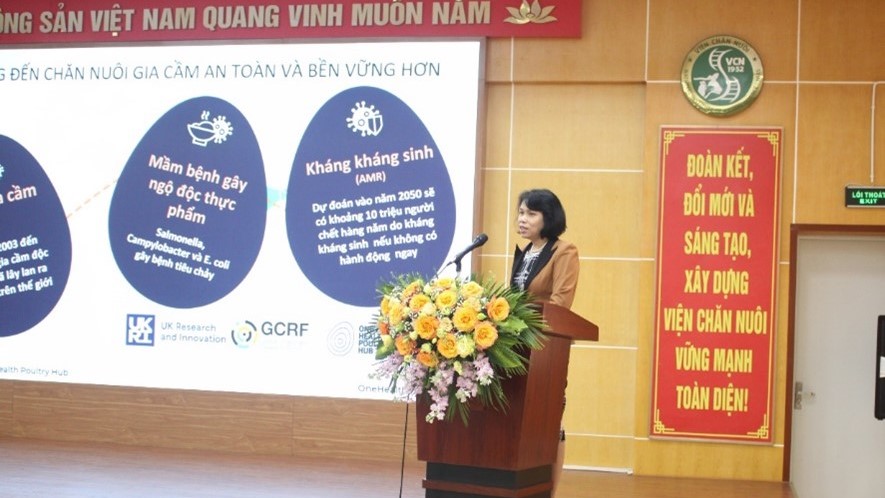
The seminars were organised in the wake of the Hub’s Roadmap series of webinars as the national Roadmap series for Vietnam. Each seminar lasted three hours and featured three presentations. There then followed discussion among the 40-50 participants present, including representatives from management agencies, including the department of animal health and department of livestock production; international organisations, including the Food and Agricultural Organization of the UN (FAO), International Livestock Research Institute ( ILRI) and GIZ, the German agency for international development; local veterinarians (sub-departments of animal health and production in the northern provinces of Vietnam) and the private sectors, including feed and drug companies, farm and livestock production associations, chicken farmers and traders.
The seminars proved excellent opportunities for key stakeholders to meet and exchange knowledge, experience and opinions. A summary of the areas covered follows.
Poultry disease management
Avian influenza (AI) is considered a complicated disease that causes high losses in poultry production and is difficult to eradicate. It spreads nearly all over the world with detections of multiple subtypes and clades of virus. In Vietnam, it occurs sporadically in the poultry population with clinical signs that may be difficult to distinguish from other respiratory or intestinal diseases. In some cases, there are two strains of AI virus found at the same outbreak: high pathogenic avian influenza (HPAI) and/or low pathogenic avian influenza (LPAI). Poultry farmers often do not recognize the disease and may use inappropriate drugs to treat their sick birds. This causes high losses for poultry farmers.
AI surveillance in Vietnam is implemented via outbreak investigations and live bird market surveillance in high-risk provinces. The main strains of AI detected are H5N1, H5N6, H5N8 and H9N2. H5N1 and H5N6 viruses have been circulating in all seven regions of Vietnam for some time (H5N1 has circulated since 2003 and H5N6 was first detected in poultry in 2014), whereas H5N8 was first introduced in the north of Vietnam in June 2021.
H9N2 was identified at different points in the chicken supply chain, and the Hub’s results indicated evidence of viral amplification from farms to endpoints. The prevalence of H9N2 increased from 4% in chicken farms to 16% in retail markets, and to 30% in slaughter facilities. The H7 subtype has not been detected in any samples since 2014.
Human and animal health agencies in Vietnam in collaboration with international organisations continue working on surveillance for influenza and potential pandemic pathogens.
In Vietnam, chicken disease management, in particular AI control, is challenging. There is limited understanding of pathogens and disease mechanisms among poultry farmers and poor biosecurity on smallholders’ farms, where around 60% of poultry production occurs. Poultry farmers often treat poultry diseases based on their experience or drug sellers’ advice. However, due to the evolution of viral strains or the combination of pathogens, it can be difficult to distinguish diseases. Thus, poultry farmers often use broad-spectrum antimicrobials for disease treatment. Poultry farmers only seek assistance from veterinary experts and collect samples for laboratory testing after trying several treatments without success.
The application of biosecurity measures at poultry farms was neither consistent and systematic, or carried out frequently. Although there are available biosecurity manuals and training courses for farmers, biosecurity measures such as isolation and entry control for poultry households are not yet strictly applied.
Antimicrobial use and antimicrobial resistance
Overuse of antimicrobials is a serious concern associated with poultry production in Vietnam. Antibiotics are no longer used as growth promoters by feed companies, but the availability of antimicrobials, lack of information on antimicrobial resistance (AMR), and farmers’ worries about diseases (i.e., farmers wanting their chickens to recover from disease quickly) has led to this situation.
Vietnam has 83 companies producing veterinary drugs and around 18,000 veterinary drug sellers. Farmers can buy antibiotics in veterinary drug shops or through marketing staff from drug companies. Vietnamese farmers do not know which antibiotics have become resistant and which are sensitive in their areas, and they often increase dosages or change antibiotics or combine several types of antibiotics if a drug is not effective at first. As a result, even though Vietnam has full regulations on antimicrobial use and prescription, the control of antibiotic use on poultry farms is still a challenge.
The Hub’s initial findings in Vietnam indicated a high prevalence (82%) of antibiotic residues in chicken meat at any detectable level. The proportion of chicken broilers with residues equal to or greater than the maximum residue limit (MRL) ranged from 7% to 19%. Nine antimicrobials were detected in chicken meat, with one in the World Health Organization’s category B list of critically important antimicrobials (restricted use for animals). Antimicrobials (e.g., sulfonamides, quinolones) were also detected in chicken feathers with proportions of 70% and 50%, respectively. These findings reveal public health concerns as well as the use and presence of antimicrobials in the environment.
There were several studies on interventions to reduce antimicrobial use (AMU) and AMR in Vietnam. Measures to reduce AMU were strengthening biosecurity and good husbandry practices, supporting farmers on disease diagnosis and recommending farmers use antimicrobial alternatives (e.g., essential oils, yeast), and these measures indicated good results (e.g., reduction of AMU, reduction of chicken deaths, increase in the live weight of chickens). However, solutions need to be identified to encourage the adoption of these interventions as they are considered high cost for farmers.
One Health and sustainability
Over the past 15 years, the poultry population in Vietnam has steadily developed, with an annual growth rate of 6%. Poultry production systems have transitioned step-by-step from smallholdings to larger farms. There are more and more enterprises invested in poultry production.
However, poultry production is facing many difficulties, such as disease outbreaks, issues related to food safety, weak linkages between production, processing and marketing, high input costs, and limited land resources.
To develop poultry production sustainably, it is necessary to:
- minimise disease outbreaks,
- manage antimicrobial use effectively,
- stabilise domestic marketing, and
- increase the export of poultry products.
Strengthening cooperation between sectors (i.e., human medicine, veterinary medicine, society, environment, industry and trade), fields (i.e., science, management and private services), localities and countries is vital to achieving these goals.
The concept of One Health and the One Health approach has been proposed many times recently but it can be general and broad. It is important to link the concept with an assessment of specific health issues that can both convince stakeholders and the community, and help them recognise and avoid problems proactively. The outputs of our One Health Poultry Hub research will do this, and so contribute to the safer and more sustainable development of poultry production in Vietnam and globally.
Focus on Vietnam


